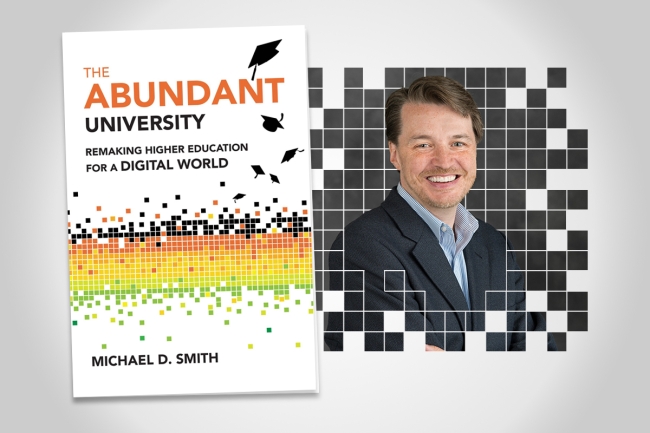You have /5 articles left.
Sign up for a free account or log in.

Michael D. Smith’s The Abundant University was published Sept. 19.
Michael D. Smith
In his new book, The Abundant University (MIT Press), Michael D. Smith, a professor of information technology and marketing at Carnegie Mellon University, examines how technology can transform higher education’s system of scarcity—in access, instruction and credentials—akin to the way streaming disrupters like Netflix overhauled the entertainment industry.
Smith spoke with Inside Higher Ed via Zoom. Excerpts of the conversation follow, edited for length and clarity.
Q: Why is higher education ripe for disruption at this point in time?
A: If you look at the coverage in the press, we’ve got a whole bunch of governments and firms who are saying, “I’m going to de-emphasize the traditional four-year degree.” What I find so interesting is they’re doing it because they want to create a more socioeconomically diverse workforce. And they can’t do that if they continue to rely on four-year degrees. That ought to be sobering and humbling for us. And I hope it’s something that would move us to action, to say, “I want to create opportunities for students who can’t afford my degree or who otherwise would be shut out because they didn’t go to the right high school. How can I do it within my existing business model? I can’t.”
Q: In the book you mentioned MIT and Stanford adopting online programs; this month alone, I wrote about both Spelman College and the University of Texas System leaning more heavily into microcredential programs. Do you think more people will continue to make the shift?
A: I really think so. When I started writing this book in 2019, 2020, there was a lot of anger when I talked about it to faculty. I’m getting less of that anger as I think we are making the shift towards, “You know what, I do want to create opportunities for people who are shut out of the system, and if that means I need to suffer a little bit, I’m willing to do that.”
Q: Is there a suffering that comes with this?
A: That’s where we get to the hard part. The hard part of all this is: Do we still need 4,500 institutions of higher education to serve demand? If these new pathways just attract people who are otherwise left out of the university system, then it doesn’t threaten the existing system. But if some of the people who were going to traditional four-year colleges now say, “I’ve got a different path, and I’m going to take it,” that’s a threat. That’s a threat to our way of doing business, our way of educating students. And I think that is starting to happen. I’m talking to more and more friends whose children are looking at colleges and who are starting to look at, “Should I just go get an apprenticeship? And just go straight to the workforce?”
Q: There’s a long list of growing alternatives to the traditional four-year degree, from online-first institutions like Southern New Hampshire University to boot camp offerings like Code Academy and apprenticeship programs utilized by Google and IBM. Is all this enough? Or do you think every university should have a digital component?
A: I would love for there to be more diversity in what universities are willing to offer online and do it more creatively. Arizona State actually teaches organic chemistry online, and what they said was, “Hey, you know what? The first 13 weeks work perfectly well online. And then we’ll just bring the students on campus for a one-week intensive lab component.” And what they discovered is not only does that give an equivalent knowledge of organic chemistry, [but] the students who walk out of the one-week lab intensive walk out of it with a much stronger identity as scientists. It’s as good, and in some ways better, than what we were delivering before. And we can deliver it at a much lower cost.
Q: In some regards, though, it is more costly to the institutions. You brought up MIT seeing such high interest in its online course program it had to add an additional 200 virtual servers. But what about institutions that cannot afford the infrastructure?
A: It’s going to be hard for 4,500 institutions to afford the digital infrastructure you need to deliver these classes. It might be the case that you get a platform [such as Coursera] that puts the digital infrastructure in place, and we can plug our courses into it. That’s the more optimistic view.
The other view is we end up with Southern New Hampshire University, ASU—[institutions] that say, “We’re going to do most of this online; we’re going to bring you in person for part of your degree program.” Which of those two visions wins out? I’m not entirely sure. But what I’m trying to say is I don’t think we can stay here.
Q: There’s also the argument of the digital divide, that pushing for online courses will create an inequity for those in rural and other areas that have poor internet access. Your book didn’t address that, but do you have thoughts on it?
A: I didn’t address the digital divide directly. What I did say is … it’s not about creating a perfect system. It’s about creating something that’s better, more equitable and more open than what we’ve got today. And I think even if you factor in the idea that some people in very rural areas might not have the high bandwidth connectivity, I still think we could create something that’s much more accessible than what we’ve got today for a lot of people.
Q: Is there going to be a tipping point of, you have to adapt or you will fail?
A: I think we’re very close to the tipping point where if you don’t get on board, you’re going to be left behind. Now, to be 100 percent clear, I think the elites—Princeton, Harvard, Yale, Stanford, MIT, I hope Carnegie Mellon—we’re going to be just fine. I would love to see us do the creative things we’re seeing out of MIT, saying, “How can I do a better job of creating a more equitable access to my resources? I think I can use technology to do that.” I hope the elites won’t say, “Well, all I have to do is keep executing my business model. I’m going to be just fine.” I hope even we will say, “No, I’m not comfortable being a finishing school for the rich and powerful.”
Q: Some argue that if institutions that are highly selective widen their access with online courses, it can water down their brand.
A: That goes back to we’re trapped in a system based on scarcity. All of our incentives tell us, no, you want to make this as scarce as possible. That’s how you benefit. I would love for us to figure out a way to pivot to “How do I create abundance, while still protecting the business model?” To be totally honest with you, I think Harvard and MIT had it right. If you think about the early days of HarvardX and MITx, I think they figured out “We’re going to provide our courses online, we’re going to provide a different credential, but we’re going to protect our existing, valuable on-campus degree.” It’s just classic responding to disruption.
Q: You repeatedly stated in your book you aren’t advocating for an all-or-nothing approach with digital adoption and believe the brick-and-mortar institutions can exist alongside their more abundant offerings. Why?
A: It would have been easy to call this book “The Death of Higher Education.” And I probably would have sold more books. But I don’t believe that’s true. What I wanted to say is, let’s really embrace that we have a system based on scarcity and we want a system based on abundance. And the only way of getting from a scarcity-based system to a system based on abundance is by adopting new technologies. I know it’s scary; I know it’s going to hurt some of us. But I hope we can pivot from trying to protect ourselves to trying to say, “I’m willing to sacrifice some of my privilege so that these students who are left out of the system today can gain access.”









